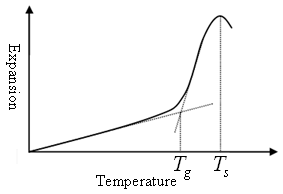|
Thermal Properties |
|||||||||||||||||
|
Thermal properties are very important for the annealing, heat treatment, thermal shock, molding and coating of optical glasses. The thermal properties are characterized by transformation temperature (Tg), sag temperature (Ts), annealing point (T1013), softening point (T107.6), mean coefficient of linear thermal expansion ( α-30/+70ºC, α100/300ºC), Thermal Conductivity (λ) and specific heat capacity (Cp).
Transformation temperature is determined by the temperature at an intersecting point of two tangents in lower and higher temperature bounds of a thermal expansion curved as shown in figure 1. Around this temperature, the glass gradually transforms from a low temperature solid glassy state to a higher temperature super-cooled liquid state. Sag temperature indicates a temperature at which expansion stops and contraction starts. The annealing point (T1013) is important for the annealing of glass. At this temperature, the internal stresses in a glass are relieved within 30 minutes and the glass has a viscosity of 1013dPa·s. The so-called softening point ( T107.6) indicates a temperature at which a glass deforms under its own weight and the glass has a viscosity of 107.6dPa·s. The mean coefficient of linear thermal expansion is given in two temperature ranges. One is from -30°C to 70°C for room temperature, while the other is from 100°C to 300°C for high temperature. Properties:
|
Copyright © 2016 Precision Micro-Optics Inc. All Rights Reserved.



